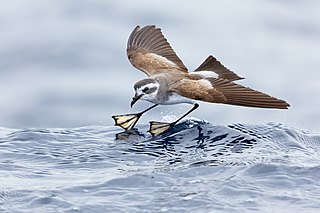
The Houtman Abrolhos is a chain of 122 islands and associated coral reefs in the Indian Ocean off the west coast of Australia about 80 kilometres (50 mi) west of Geraldton, Western Australia. It is the southernmost true coral reef in the Indian Ocean, and one of the highest latitude reef systems in the world.

The white-faced storm petrel, also known as white-faced petrel or frigate petrel is a small seabird of the austral storm petrel family Oceanitidae. It is the only member of the monotypic genus Pelagodroma. It is widely distributed across the northern and southern hemisphere, especially around the coastal and open ocean waters of southern Australia, New Zealand, Tristan da Cunha, Cabo Verde, the Canary islands and the Selvagens islands.

The painted buttonquail is a species of buttonquail, the family Turnicidae, which resemble, but are unrelated to, the quails of Phasianidae. This species is resident in Australia where numbers are believed to be in decline. A subspecies, the Abrolhos painted buttonquail, is endemic to the Houtman Abrolhos islands.

Alexander Island is one of the five largest islands in the Easter Group of the Houtman Abrolhos. The island is part of the Houtman Abrolhos Important Bird Area, identified as such by BirdLife International because of its importance for supporting large numbers of breeding seabirds.

The Wallabi Group is the northernmost group of islands in the Houtman Abrolhos off the western coast of Western Australia. it is 58 kilometres from the Australian mainland, and about 9 kilometres from the Easter Group.

The Easter Group is the central of three groups of islands that make up the Houtman Abrolhos island chain. The group measures about 20 kilometres by 12 kilometres, and consists of a number of islands including

The Pelsaert Group is the southernmost of the three groups of islands that make up the Houtman Abrolhos island chain. It consists of a number of islands, the largest of which are Gun Island, Middle Island, and Pelsaert Island. The group is named after Francisco Pelsaert a Dutch "opperkoopman", who stranded nearby with the VOC-ship "Batavia" in 1629. The group contains the most southerly true coral reefs in the Indian Ocean. The group is part of the Houtman Abrolhos Important Bird Area, identified as such by BirdLife International because of its importance for supporting large numbers of breeding seabirds.

North Island is the northernmost island in the Houtman Abrolhos, a coral reef archipelago in the Indian Ocean off the coast of Mid West Western Australia. Located about 14 km (9 mi) from the nearest island group, it is one of the largest islands in the Houtman Abrolhos, and one of the few to support dune systems. It has relatively diverse flora dominated by chenopod shrubs and fauna that includes the introduced tammar wallaby, around seven species of reptile, and about 15 resident bird species.

North East Reef is a reef in the Wallabi Group of the Houtman Abrolhos, in the Indian Ocean off the coast of Western Australia. Located at 28°25′13″S113°48′41″E, it takes its name from the fact that it is situated to the north-east of the main body of islands that makes up the Wallabi Group. The island is part of the Houtman Abrolhos Important Bird Area, identified as such by BirdLife International because of its importance for supporting large numbers of breeding seabirds.

Gun Island is one of the larger islands in the Pelsaert Group of the Houtman Abrolhos, in the Indian Ocean off the west coast of Australia. It is nominally at 28°53′10″S113°51′35″E, about 4 km (2.5 mi) north and east of Half Moon Reef and is a flat limestone outcrop of about 800 by 420 metres in size. The island is part of the Houtman Abrolhos Important Bird Area, identified as such by BirdLife International because of its importance for supporting large numbers of breeding seabirds.

The Abrolhos painted buttonquail is a subspecies of the painted buttonquail endemic to the Houtman Abrolhos. It is common on North Island, and also occurs on other islands of the Wallabi Group, namely East Wallabi, West Wallabi, Seagull and Pigeon Islands.

The Southwest Shelf Transition, also known as the Houtman marine ecoregion, is a biogeographic region of Australia's continental shelf and coastal waters. It includes the subtropical coastal waters of Southwest Australia.
Ronald Eric Johnstone is an Australian ornithologist and herpetologist who worked for the Western Australian Museum for many years. The bat species Otomops johnstonei is named in his honour. The lizard species Carlia johnstonei is named in his honor.

East Wallabi Island is an island in the Wallabi Group of the Houtman Abrolhos, located in the Indian Ocean off the west coast of mainland Australia.

West Wallabi Island is an island in the Wallabi Group of the Houtman Abrolhos, in the Indian Ocean off the west coast of mainland Australia.

Pelsaert Island is one of the islands of the Pelsaert Group, which is the southernmost of the three groups of islands that make up the Houtman Abrolhos island chain in Western Australia.

Beacon Island, also known as Batavia's Graveyard, is an island on the eastern side of the Wallabi Group at the northern end of the Houtman Abrolhos, in the Indian Ocean, off the coast of Western Australia.

Houtman Abrolhos Islands National Park is a national park in the Mid West region of Western Australia, 75 km (47 mi) west of Geraldton. It was declared on 5 July 2019, is located in the City of Greater Geraldton, and is part of the Geraldton Sandplains bioregion.













